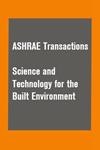高玻璃住宅水循环地暖与制冷模型预测控制器的研究
IF 1.7
4区 工程技术
Q3 CONSTRUCTION & BUILDING TECHNOLOGY
Science and Technology for the Built Environment
Pub Date : 2023-03-30
DOI:10.1080/23744731.2023.2196910
引用次数: 3
摘要
本文介绍了在加拿大渥太华的一幢高玻璃房屋中对水循环地板采暖和制冷的模型预测控制器(MPC)的研究结果。本研究的目的是确定与现有的无功控制器(RC)相比,MPC是否能同时降低能耗和室内空气温度(Tia)违规。通过实验和模拟显示,预测控制的结果是,Tia在可接受范围(19.5-25°C)之间的时间更长,加热和冷却系统的运行时间明显减少。在实验中,与RC基线相比,“伪预测控制器”(PPC)所需的冷却时间减少了35%,加热时间减少了50%。PPC还将过热时间缩短了88%。然后设计了一个简单的MPC,并使用MATLAB仿真与RC进行了比较。即使使用简单且未优化的MPC,模拟也证实了该MPC相对于RC操作的水力地板系统的优越性。与模拟RC相比,模拟MPC所需的冷却时间减少28%,加热时间减少27%。这些结果证实了预测控制的前景,下一步包括在高玻璃房屋中长期实际实施所提出的MPC。本文章由计算机程序翻译,如有差异,请以英文原文为准。
Investigation of a model predictive controller for use in a highly glazed house with hydronic floor heating and cooling
Presented are the results of an investigation into a model predictive controller (MPC) for hydronic floor heating and cooling in a highly glazed house in Ottawa, Canada. The goal of this investigation was to determine if a MPC would simultaneously result in reduced energy consumption and reduced indoor air temperature (Tia) violations in comparison to the incumbent reactive controller (RC). Shown both experimentally and via simulation, predictive control results in more hours with Tia between the acceptable limits (19.5–25 °C) for significantly less heating and cooling system operation hours. Experimentally, a “pseudo-predictive controller” (PPC) required 35% less cooling hours and 50% less heating hours than the RC baseline. The PPC also reduced overheating time by 88%. A simple MPC was then designed and compared to a RC using a MATLAB simulation. Even with a simple and non-optimized MPC, the simulation confirmed the superiority of said MPC over RC operation for the hydronic floor system. The simulated MPC required 28% less cooling hours and 27% less heating hours than the simulated RC. These results have confirmed the suspected promise of predictive control and next steps include actual implementation of the presented MPC in the highly glazed house long-term.
求助全文
通过发布文献求助,成功后即可免费获取论文全文。
去求助
来源期刊

Science and Technology for the Built Environment
THERMODYNAMICSCONSTRUCTION & BUILDING TECH-CONSTRUCTION & BUILDING TECHNOLOGY
CiteScore
4.30
自引率
5.30%
发文量
78
期刊介绍:
Science and Technology for the Built Environment (formerly HVAC&R Research) is ASHRAE’s archival research publication, offering comprehensive reporting of original research in science and technology related to the stationary and mobile built environment, including indoor environmental quality, thermodynamic and energy system dynamics, materials properties, refrigerants, renewable and traditional energy systems and related processes and concepts, integrated built environmental system design approaches and tools, simulation approaches and algorithms, building enclosure assemblies, and systems for minimizing and regulating space heating and cooling modes. The journal features review articles that critically assess existing literature and point out future research directions.
 求助内容:
求助内容: 应助结果提醒方式:
应助结果提醒方式:


